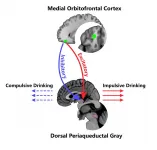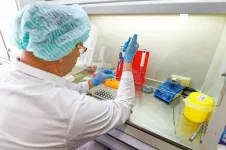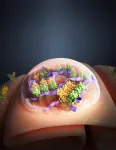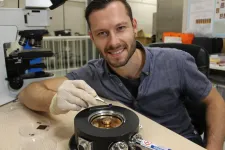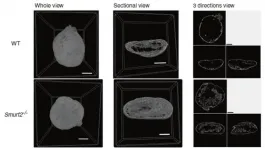Brain protein that causes Alzheimer's also protects against the disease: USask research
2021-02-08
(Press-News.org) Findings from a new study on Alzheimer's disease (AD), led by researchers at the University of Saskatchewan (USask), could eventually help clinicians identify people at highest risk for developing the irreversible, progressive brain disorder and pave the way for treatments that slow or prevent its onset.
The research, published in the journal Scientific Reports in early January, has demonstrated that a shorter form of the protein peptide believed responsible for causing AD (beta-amyloid 42, or Aβ42) halts the damage-causing mechanism of its longer counterpart.
"While Aβ42 disrupts the mechanism that is used by brain cells to learn and form memories, Aβ38 completely inhibits this effect, essentially rescuing the brain cells," said molecular neurochemist Darrell Mousseau, professor in USask's Department of Psychiatry and head of the Cell Signalling Laboratory.
Previous studies have hinted that Aβ38 might not be as bad as the longer form, said Mousseau, but their research is the first to demonstrate it is actually protective.
"If we can specifically take out the Aβ42 and only keep the Aβ38, maybe that will help people live longer or cause the disease to start later, which is what we all want."
Aβ42 is toxic to cells, disrupts communication between cells, and over time accumulates to form deposits called plaques. This combination of factors is believed responsible for causing AD. Experts have long thought that all forms of Aβ peptides cause AD, despite the fact that clinical trials have shown removing these peptides from the brains of patients does not prevent or treat the disease.
Mousseau said the idea behind the study was simple enough: If two more amino acids is bad, what about two less?
"We just thought: Let's compare these three peptides, the 40 amino acid one that most people have, the 42 amino acid that we think is involved in Alzheimer's, and this 38 one, the slightly shorter version," said Mousseau, who is Saskatchewan Research Chair in Alzheimer disease and related dementias, a position co-funded by the Saskatchewan Health Research Foundation and the Alzheimer Society of Saskatchewan.
The project confirmed the protective effects of the shorter protein across a variety of different analyses: in synthetic versions of the protein in test tubes; in human cells; in a worm model widely used for studying aging and neurodegeneration; in tissue preparations used to study membrane properties and memory; and in brain samples from autopsies. In the brain samples, they also found that men with AD who had more Aβ42 and less Aβ38 died at an earlier age. The fact that they didn't see this same pattern in samples from women suggests the protein peptide behaves differently in men and women.
The USask team also included Maa Quartey and Jennifer Nyarko from the Cell Signalling Lab (Department of Psychiatry), Jason Maley at the Saskatchewan Structural Sciences Centre, Carlos Carvalho in the Department of Biology, and Scot Leary in the Department of Biochemistry, Microbiology and Immunology. Joseph Buttigieg at the University of Regina and Matt Parsons at Memorial University of Newfoundland were also part of the research team.
While Mousseau wasn't surprised to see that the shorter form prevents the damage caused by the longer version, he said he was a little taken aback at how significant an effect it had.
"As soon as you put Aβ38 into it, it brings it back up to control levels, completely inhibiting the toxic effects of Aβ42. That's what was pleasantly surprising."
INFORMATION:
[Attachments] See images for this press release:
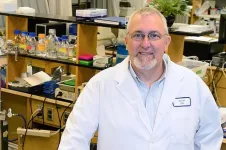
ELSE PRESS RELEASES FROM THIS DATE:
2021-02-08
A pathway in the brain where alcohol addiction first develops has been identified by a team of British and Chinese researchers in a new study
Could lead to more effective interventions when tackling compulsive and impulsive drinking
More than 3 million deaths every year are related to alcohol use globally, according to the World Health Organisation
The physical origin of alcohol addiction has been located in a network of the human brain that regulates our response to danger, according to a team of British and Chinese researchers, co-led by the University of Warwick, the University ...
2021-02-08
On a brisk November morning in 2018, a fire sparked in a remote stretch of canyon in Butte County, California, a region nestled against the western slopes of the Sierra Nevada mountains. Fueled by a sea of tinder created by drought, and propelled by powerful gusts, the flames grew and traveled rapidly. In less than 24 hours, the fire had swept through the town of Paradise and other communities, leaving a charred ruin in its wake.
The Camp Fire was the costliest disaster worldwide in 2018 and, having caused 85 deaths and destroyed more than 18,000 buildings, it became both the deadliest and most destructive wildfire ...
2021-02-08
An unusual biologically active porphyrin compound was isolated from seabed dweller Ophiura sarsii. The substance might be used as an affordable light-sensitive drug for innovative photodynamic therapy and for targeted treatment of triple-negative breast cancer and some other cancers. Researchers from the School of Biomedicine of Far Eastern Federal University (FEFU) and the University of Geneva reported the findings in Marine Drugs.
The seabed dweller Ophiura sarsii, the source of the new compound, was isolated at a depth of 15-18 meters in Bogdanovich Bay, Russky Island (Vladivostok, Russia). Ophiuras may resemble ...
2021-02-08
DALLAS - Feb. 8, 2021 - Pregnant women, who are at increased risk of preterm birth or pregnancy loss if they develop a severe case of COVID-19, need the best possible guidance on whether they should receive a COVID-19 vaccine, according to an article by two UT Southwestern obstetricians published today in JAMA. That guidance can take lessons from what is already known about other vaccines given during pregnancy.
In the Viewpoint article, Emily H. Adhikari, M.D., and Catherine Y. Spong, M.D., describe how the available safety and effectiveness data, basic science of mRNA vaccines, and long history ...
2021-02-08
DALLAS - Feb. 8, 2021 - A new nanoparticle-based drug can boost the body's innate immune system and make it more effective at fighting off tumors, researchers at UT Southwestern have shown. Their study, published in Nature Biomedical Engineering, is the first to successfully target the immune molecule STING with nanoparticles about one millionth the size of a soccer ball that can switch on/off immune activity in response to their physiological environment.
"Activating STING by these nanoparticles is like exerting perpetual pressure on the accelerator to ramp up the natural innate immune response to a tumor," says study leader Jinming Gao, Ph.D., a professor in UT Southwestern's Harold C. Simmons Comprehensive ...
2021-02-08
AURORA, Colo. (February 8, 2021) - Researchers from the Barbara Davis Center for Childhood Diabetes at the University of Colorado Anschutz Medical Campus have found that immune responses to insulin could help identify individuals most at risk for developing Type 1 diabetes.
The study, out recently in the Proceedings of the National Academy of Sciences, measured immune responses from individuals genetically predisposed to developing Type 1 diabetes (T1D) to naturally occurring insulin and hybrid insulin peptides. Since not all genetically predisposed individuals ...
2021-02-08
An international team of scientists has invented the equivalent of body armour for extremely fragile quantum systems, which will make them robust enough to be used as the basis for a new generation of low-energy electronics.
The scientists applied the armour by gently squashing droplets of liquid metal gallium onto the materials, coating them with gallium oxide.
Protection is crucial for thin materials such as graphene, which are only a single atom thick - essentially two-dimensional (2D) - and so are easily damaged by conventional layering technology, said Matthias Wurdack, who is the lead author of the group's publication in Advanced Materials.
"The protective coating ...
2021-02-08
A framework designed to provide detailed information on agricultural groundwater use in arid regions has been developed by KAUST researchers in collaboration with the Saudi Ministry of Environment Water and Agriculture (MEWA).
"Groundwater is a precious resource, but we don't pay for it to grow our food, we just pump it out," says Oliver López, who worked on the project with KAUST's Matthew McCabe and co-workers. "When something is free, we are less likely to keep track of it, but it is critical that we measure groundwater extraction because it impacts both food and water security, not just regionally, but globally."
Saudi Arabia's farmland is often irrigated via center pivots that tap underground aquifer sources. The team has built a powerful tool ...
2021-02-08
Osaka, Japan - Bone morphogenetic protein (BMP) has a strong osteogenic (bone forming) ability. BMP has already been clinically applied to spinal fusion and non-union fractures. However, dose-dependent side effects related to BMP use, such as inflammatory reactions at the administration site, prevent widespread use.
For safe use, it was necessary to clarify how the BMP signaling pathway is controlled. In a report published in Bone Research, a group of researchers from Osaka University and Ehime University has recently identified a novel role for the protein Smurf2 in regulating bone formation by BMP.
When BMP transmits its message within cells, it can induce rapid bone formation. Previous studies have shown that Smurf2 can control another similar ...
2021-02-08
Lithium metal batteries could double the amount of energy held by lithium-ion batteries, if only their anodes didn't break down into small pieces when they were used.
Now, researchers led by Prof. CUI Guanglei from the Qingdao Institute of Bioenergy and Bioprocess Technology (QIBEBT) of the Chinese Academy of Sciences (CAS) have identified what causes lithium metal batteries (LMBs) to "self-destruct" and proposed a way to prevent it. The findings were published in Angewandte Chemie on Jan. 19.
This offers hope of radically enhancing the energy held in batteries without any increase in their size, and at reduced cost.
In fact, LMBs were the original concept for long-lasting ...
LAST 30 PRESS RELEASES:
[Press-News.org] Brain protein that causes Alzheimer's also protects against the disease: USask research

